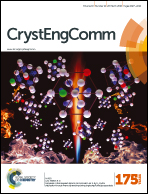Growth of hollow-structured LiMn2O4 crystals starting from Mn metal in molten KCl through the microscale Kirkendall effect†
Abstract
Hollow-structured LiMn2O4 crystals are grown in molten KCl (flux) for the first time via an oxidation reaction of metallic Mn followed by a lithiation reaction. Characterization of the formation process, which is achieved using thermogravimetric differential thermal analysis, X-ray diffraction, and scanning electron microscopy observation, reveals that the hollow structures are formed via a mechanism analogous to the microscale Kirkendall effect, which results from the difference between the solid-state diffusion rates of the core materials and the rate of O2 diffusion through the shell at elevated temperatures occurring during oxidation. Interestingly, the development of well-defined crystal facets is observed on the surfaces of the LiMn2O4 crystals, implying that the crystal growth is driven by supersaturation in the same manner as the flux growth. We also examine two possible approaches to reduce the volume of the inner space in the crystal: crystal growth under O2 flow for enhancement of the O2 diffusion and insertion of a Co and Ni layer between Mn and the substrate to induce the formation of the LiNi1/3Co1/3Mn1/3O2 phase.


 Please wait while we load your content...
Please wait while we load your content...